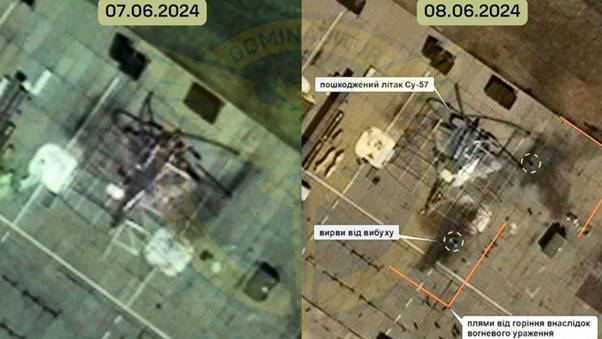Damaged Su-57 Emphasises the Vulnerability of Russian Airbases Near Ukraine
Ukraine’s apparent success in damaging a Su-57 is a substantial blow to Russia’s long-troubled stealth fighter fleet, and another Illustration of Ukraine’s most effective option for countering increasingly effective Russian air attacks on the frontlines.
The Defense Intelligence Directorate of Ukraine (GUR) has released satellite imagery that appears to support its claim to have damaged at least one Russian Sukhoi Su-57 ‘Felon’ fighter aircraft on the ground at the 929th VP Chkalova State Flight Test Centre in Akhtubinsk. Akhtubinsk airfield is located around 370 miles from Ukrainian-held territory, placing it beyond the reach of most of the long-range strike weapons supplied so far by Western countries, but the attack was reportedly carried out by three one-way attack (OWA) drones. Ukraine has developed a wide variety of such drones, which range from small and very slow propellor-powered craft with a very small warhead to adapted jet-powered target and reconnaissance drones that are much larger and faster and carry heavier warheads. It has been using these often fairly cheap and easy-to-produce weapons to carry out a determined harassment campaign deep inside Russia against factories, port facilities, oil refineries and airbases. If, as Russian Telegram channels seem to confirm, a Su-57 has indeed been significantly damaged, this would represent one of the higher-profile successes of such weapons, alongside the destruction of a Russian Tu-22M3 bomber and damage caused to a Tu-95MS bomber.
Impact on Su-57 Operations

It is unclear how much damage the Su-57 in question has sustained. The satellite photo appears to suggest that two relatively small explosions occurred within around 3–5 metres of the aircraft, which was parked on an outdoor concrete hardstand. Some sort of transparent dust shelter or netting may be covering the aircraft, as there appears to be some sort of lightweight arching structure suspended over it in both photos. This might in fact be anti-drone netting intended to stop a lightweight propellor-powered OWA weapon from hitting the aircraft. If so, it failed, as both warheads appear to have exploded on the ground on either end of the left-hand side of the ‘shelter’ structure, where shrapnel would have been able to damage both the front nose section and the tail section of the aircraft. Shrapnel damage to the rear section might be relatively easy to repair with an engine change and replacement horizontal and vertical stabilisers, but shrapnel damage of any significance to the nose section would be much more serious. It would likely cause damage to the radar array(s), Infra-Red Scan and Track sensor, and cockpit, as well as instruments and electronic systems critical to the functioning of the whole aircraft. However, the Su-57 looks to have avoided a serious fire from the strikes, which would likely have resulted in irreparable damage, so depending on the severity of the shrapnel damage it may well be repaired and returned to service.
Repairs will, however, be expensive and will take additional time compared to similar repairs to less advanced aircraft. The Su-57 has yet to enter full-rate production, since the decision to do so is awaiting the development of the ‘definitive’ Su-57M version, meaning that spare parts are likely to be in limited supply. As such, the Su-57 is still a very rare commodity in the Russian Aerospace Forces (VKS), with only around 15–20 likely to be in frontline service. Former Defence Minister Sergei Shoigu stated in December 2020 that the VKS expected to receive 22 Su-57s by the end of 2024. However, at the start of the invasion of Ukraine, only four series production aircraft had been delivered, as the first crashed and was completely destroyed during its acceptance trials. Around 12 are claimed to have been delivered in 2023, but no deliveries in 2024 had been announced by April 2024 despite multiple announcements of other types, so the total number in service is unclear. It is likely that Su-57 development and production is also being slowed down by Sukhoi needing to focus on maximising output of mature fighters like the Su-30SM2 and Su-35S to replace significant combat losses incurred in the war against Ukraine. International sanctions have also made it far more difficult for Russia to source the Western avionics and micro-electronics that have been essential components of its advanced fighter and attack aircraft cockpits for more than a decade. Thus, even the temporary loss of one Su-57 airframe in this Ukrainian strike likely represents at least a 5% cut in the frontline fleet of Russia’s most advanced fighter aircraft. It is also a significant symbolic blow to an already long-troubled aircraft programme that is a centrepiece of Russian military pride.
Airfield Strikes as Part of the War
Despite its impact on the VKS’s most prestigious fighter fleet, the direct effects of this strike on the progress of the war in Ukraine will be almost non-existent. Due to its small fleet size, the political humiliation if one were to be shot down, and slow aircraft systems development, the Su-57 has played an extremely minor role in the conflict to date. However, the strike is illustrative of the fact that Ukraine now has a relatively mature low-cost long-range harassment capability that it can use against VKS bases a long way inside Russia.
This is important for the course of the entire war, because over the past six months the fighter and strike fighter aircraft of the VKS have been having an increasingly pronounced impact on the frontline after almost two years of relative ineffectiveness. The main tool that has enabled this is the mass production of wing-kits featuring GPS/GLONASS guidance that can turn Russia’s stockpile of thousands of FAB-series 250 kg, 500 kg and 1,500 kg unguided demolition bombs into standoff precision weapons against fixed targets like buildings and battlefield fortifications. These weapons are having a serious impact on Ukrainian soldiers’ morale, making it harder to hold key defensive positions and causing huge destruction in urban areas.
Kyiv appears to be pursuing a clear strategy to force the VKS to either vacate its bases within several hundred miles of Ukraine’s borders or dedicate an inordinate quantity of air defence systems to defending them
The glide bombs are generally released by Russian jets flying at high altitudes and speeds between 60 km and 70 km behind the frontlines. This means that the launch aircraft are very difficult to shoot down, even with long-range Patriot PAC-2 surface-to-air missile systems (SAMs). Ukraine has done so several times, but this requires risking the scarce and vital Patriot systems very close to the frontlines, and some launch vehicles have been found by Russian observation UAVs and destroyed during such missions. With so many competing demands for missile defence for power infrastructure, cities and bases throughout Ukraine, long-range SAMs are too valuable to routinely risk trying to take long shots at glide bomb-launching fighters. It is also not viable to directly intercept the bombs in flight, because doing so would very rapidly deplete all of Ukraine’s SAM ammunition.
Even when the long-awaited pan-European F-16s and later planned Swedish Gripen C and French Mirage 2000-5F fighters are delivered to Ukraine, the glide bomb sorties will be very challenging to intercept regularly. When close to the frontlines, Ukrainian pilots will have to fly them at very low altitudes to avoid being detected and shot down by layered Russian short-range SA-15 ‘Tor M1/2’, medium-range SA-11/17/27 ‘Buk’ and long-range SA-21 ‘Growler’ and SA-23 ‘Gladiator\Giant’ SAM systems. As a result, the AIM-120C AMRAAM air-to-air missiles carried by the F-16 and Gripen C, and the shorter-range MICA IR/RF missiles carried by Mirage 2000-5F, will struggle to reach Russian fighters at high altitudes and high speeds 60–70 km behind the lines. This is because at such low altitudes, the missiles start out in dense air with a lot of aerodynamic drag and must climb against gravity to reach the altitudes where their targets are. As a result, by the time their rocket motors burn out after the first few seconds of flight, they have not gained nearly as much speed or altitude as if they were launched from a fighter flying in the thin air at high altitudes and at supersonic speeds, and so only have a comparatively short effective range. Only the European Meteor missile is likely to have the practical range required, and of the three fighter options now publicly discussed for Ukraine, only the Gripen C can carry and launch it.
Therefore, for now, attacks on Russian airbases are Ukraine’s best way to limit the damage that the VKS can do to its forces on the frontlines. Most Russian forward-deployment airfields lack hardened aircraft shelters to protect parked aircraft from even relatively light incoming weapons. This is why Ukraine’s innovative OWA drones have been able to have several notable successes in damaging and even destroying Russian fighters, bombers and AWACS aircraft despite their often fragile appearance, light warheads and slow speeds. Ukraine also conducted successful strikes with a new tranche of US-supplied MGM-140 ATACMS ballistic missiles on air defence systems and parked aircraft at Russian airbases in occupied Crimea in April. Taken together, Kyiv appears to be pursuing a clear strategy to force the VKS to either vacate its bases within several hundred miles of Ukraine’s borders or dedicate an inordinate quantity of air defence systems to defending them. The former would reduce the functional strike weight of glide bombs and other weapons that the VKS can deliver by forcing Russian jets to transit significantly further, burning through more fuel and aircrew and airframe fatigue and reducing overall sortie rates. The latter would denude other parts of the frontline and the Russian interior of adequate SAM cover, allowing greater operational freedom for Ukraine’s OWA drones, rocket artillery, observation UAVs and possibly F-16 and other fighters when they arrive.
The views expressed in this Commentary are the author’s, and do not represent those of RUSI or any other institution.
Have an idea for a Commentary you’d like to write for us? Send a short pitch to commentaries@rusi.org and we’ll get back to you if it fits into our research interests. Full guidelines for contributors can be found here.
WRITTEN BY
Justin Bronk
Senior Research Fellow, Airpower & Technology
Military Sciences
- Jim McLeanMedia Relations Manager+44 (0)7917 373 069JimMc@rusi.org



